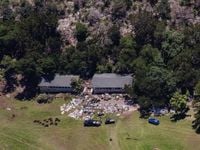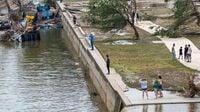On the night of July 4, 2025, as families across Texas celebrated Independence Day, a catastrophe was quietly unfolding in the Hill Country. Torrential rains, fueled by the remnants of Tropical Storm Barry and an unusual confluence of atmospheric conditions, triggered a flash flood that would become one of the deadliest in the state’s recent history. By the time the waters receded, more than 130 lives had been lost across six counties, with Kerr County bearing the brunt of the devastation. Among the victims were 25 campers and two counselors at Camp Mystic, a private Christian girls’ camp on the banks of the Guadalupe River, as well as the camp’s owner and director, Dick Eastland.
Now, in the aftermath, the grief-stricken families of the victims are seeking answers—and accountability. On November 10, 2025, multiple lawsuits were filed in Travis County District Court against Camp Mystic and its ownership, alleging a litany of failures that, they say, turned a natural disaster into a preventable tragedy. The filings, which collectively represent the families of at least seven girls and several counselors, accuse the camp of gross negligence, premises liability, and intentional infliction of emotional distress. They are seeking over $1 million in damages and have requested a jury trial.
According to Fox News, the lawsuits paint a harrowing picture of the events that unfolded on that fateful night. The petitions allege that Camp Mystic, which spans 725 acres along the Guadalupe River in an area known as "Flash Flood Alley," not only ignored repeated weather warnings and state safety regulations, but also prioritized the protection of equipment over the lives of campers and counselors. A detailed timeline included in one lawsuit describes how, at 1:14 a.m., the National Weather Service issued a "life-threatening flash flood" warning. Yet, rather than ordering an immediate evacuation, camp leaders Richard and Edward Eastland allegedly spent the next hour moving equipment to safety. Counselors reportedly pleaded to evacuate girls from low-lying cabins but were told to "stay put because that’s the plan."
By 2:20 a.m., water was entering cabins, yet the order remained: stay inside. Some cabins were eventually evacuated to a recreation hall on higher ground, but others—including Nut Hut, Chatter Box, Wiggle Inn, Giggle Box, Twins, and Bubble Inn—were left behind. The consequences were devastating. Between 3:35 and 3:51 a.m., Richard Eastland’s SUV was swept away as he attempted to rescue girls from Bubble Inn; all 13 campers and two counselors in that cabin drowned. In the Twins cabin, eleven campers died after being told to stay put because "the water would go back down." The families’ lawsuits argue that, had the girls been allowed to evacuate, they could have reached higher ground within 60 seconds.
As reported by Courthouse News, the parents of six deceased campers, aged 8 to 9, described the terror their daughters faced: “These innocent little girls are unable to express to their parents the terror they experienced as water rose in their cabins, as they desperately tried to keep their heads above the steadily rising water, attempting to escape, and then as they were swept into raging flood waters. Their parents are left to live every single day for the rest of their lives with the intense grief and the thoughts of what their babies endured that fateful night.”
The lawsuits highlight a critical document found among a counselor’s belongings: the camp’s flood emergency protocol. It consisted of a single paragraph instructing campers to remain in their cabins unless told otherwise by the office, with the assertion that all cabins were on "high, safe ground." Plaintiffs contend that this was not only untrue, but that the policy itself amounted to a “death sentence.” The suits allege that Camp Mystic had long operated in a high-risk flood zone and had failed to adopt legally required evacuation plans, ignored weather warnings, and implemented unsafe policies. “Camp Mystic has long operated in a high-risk flood zone. Despite this known danger, the petition asserts that the camp failed to adopt legally required evacuation plans, ignored repeated weather warnings, and implemented unsafe policies,” attorneys for the plaintiffs said, according to NBC News.
One particularly damning allegation is that staff were directed to move camp equipment instead of evacuating campers and counselors as the river rose. “With the river rising, the Camp chose to direct its groundskeepers to spend over an hour evacuating camp equipment, not its campers and counselors,” the suit states. In some cases, two cabins were ordered to stay put even as others were moved to higher ground just 300 feet away. “Finally, when it was too late, the Camp made a hopeless 'rescue' effort from its self-created disaster in which 25 campers, two counselors, and the Camp director died,” the suit continues.
Adding to the families’ anguish, the lawsuits allege that Camp Mystic administrators misled them after the disaster, referring to missing girls as merely “unaccounted for” long after the floodwaters had receded. The camp also announced plans to partially reopen for the next summer season while at least one camper, Cile Steward, remained missing. “There is no greater trust than when a parent entrusts the care of their child to another. Parents don’t send their children to summer camp to die,” wrote Timothy and Melissa Peck, whose daughter Eloise “Lulu” Peck was among the victims. “Camp Mystic and the people who ran it betrayed that trust.”
The lawsuits further allege that the dangers of the site were long known to the owners. One suit claims that the Eastland family had been aware since 1932 that the cabins “sat in the bullseye of potential flood waters from the Guadalupe River and never said a word about it to trusting parents.” The petition references a 1990 interview with then-director Richard Eastland, who reportedly told the Austin-American Statesman, “I’m sure there will be other drownings. People don’t heed the warnings.”
Camp Mystic and its legal representatives have pushed back against the accusations. In a statement quoted by Axios and NBC News, the camp said, “We empathize with the families of the campers and counselors and all families in the Hill Country who lost loved ones in the horrific and unprecedented flood of July 4. We intend to demonstrate and prove that this sudden surge of floodwaters far exceeded any previous flood in the area by several magnitudes, that it was unexpected and that no adequate warning systems existed in the area. We disagree with several accusations and misinformation in the legal filings regarding the actions of Camp Mystic and Dick Eastland, who lost his life as well. We will thoroughly respond to these accusations in due course.”
Prominent Texas lawyer Mikal Watts, who is defending Camp Mystic pro bono, has argued that the tragedy was the result of a lack of a siren warning system in the area, not negligence by the camp. “There is no jury in America that will hold Camp Mystic responsible,” Watts has said, according to Courthouse News.
The disaster itself, as chronicled by NBC News and NASA, was caused by an extraordinary meteorological event. The Guadalupe River rose over 20 feet in just a few hours, with some areas receiving more than 20 inches of rainfall. Drought conditions in the region, which had persisted since late 2021, hardened the soil and exacerbated the flash flooding. The slow-moving thunderstorms that lingered from July 4 to July 7, 2025, created a perfect storm—one that exposed longstanding vulnerabilities and raised urgent questions about preparedness and responsibility.
As Camp Mystic plans to partially reopen next year with a monument to the victims, the families’ lawsuits seek not only compensation, but also lasting change. Their filings argue that only through accountability and reform can future tragedies be prevented—and that the memory of those lost will not be in vain.






